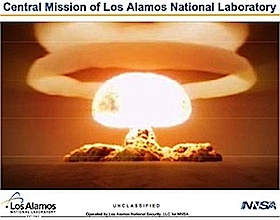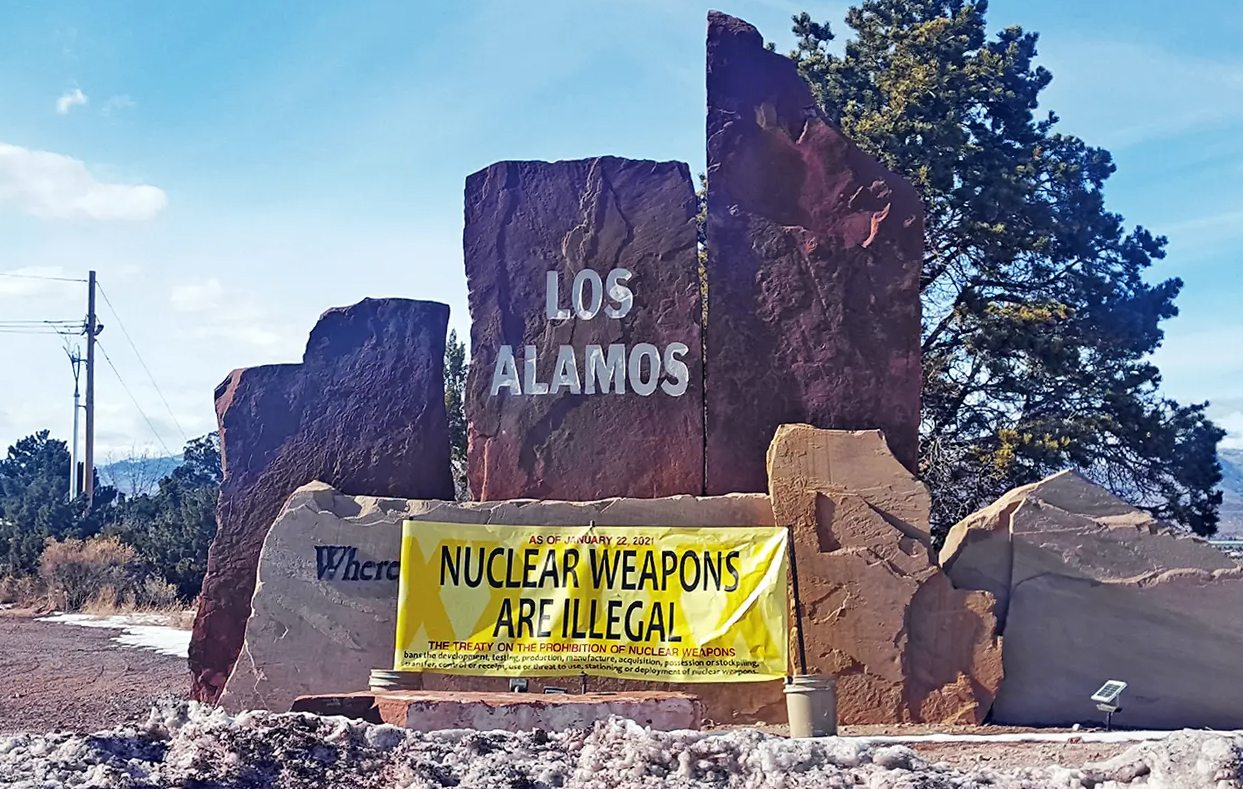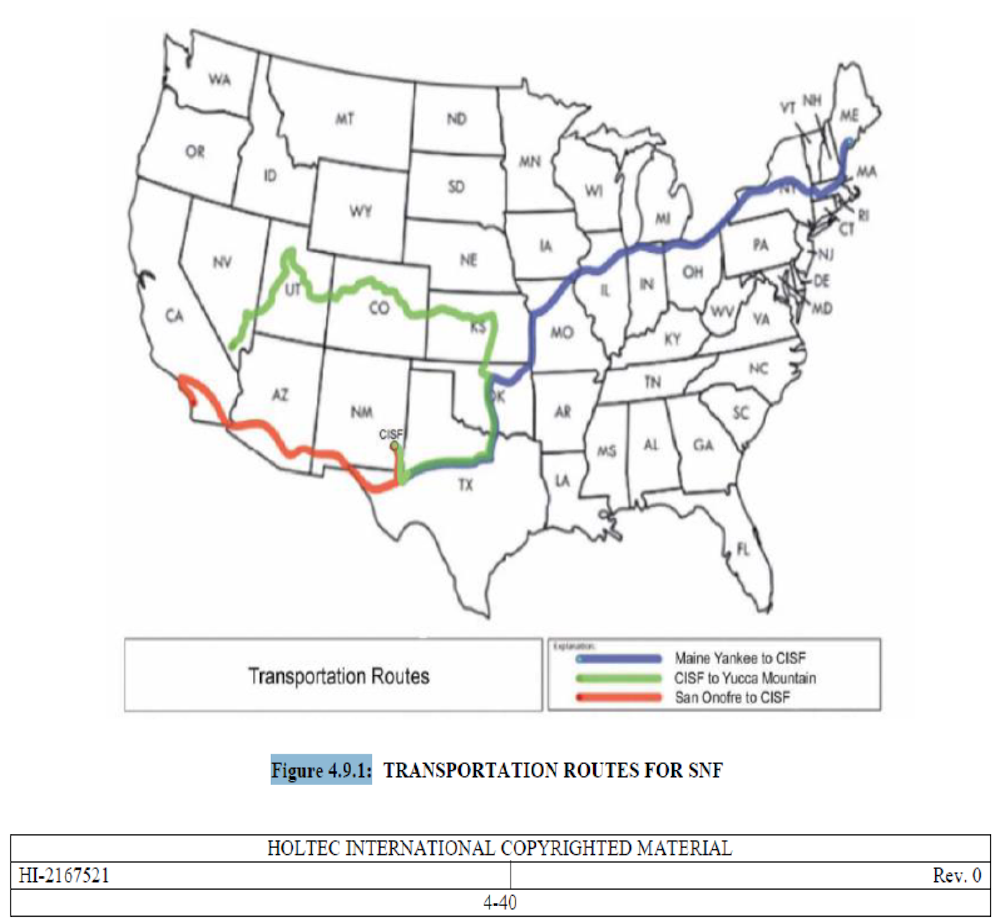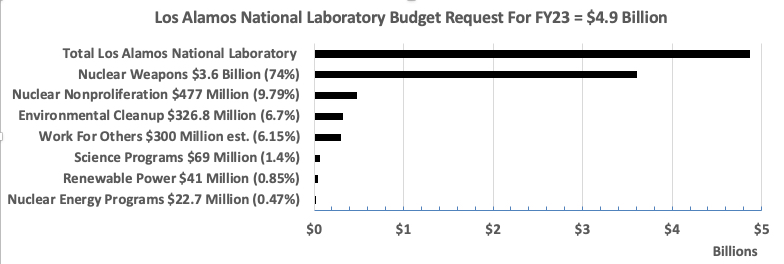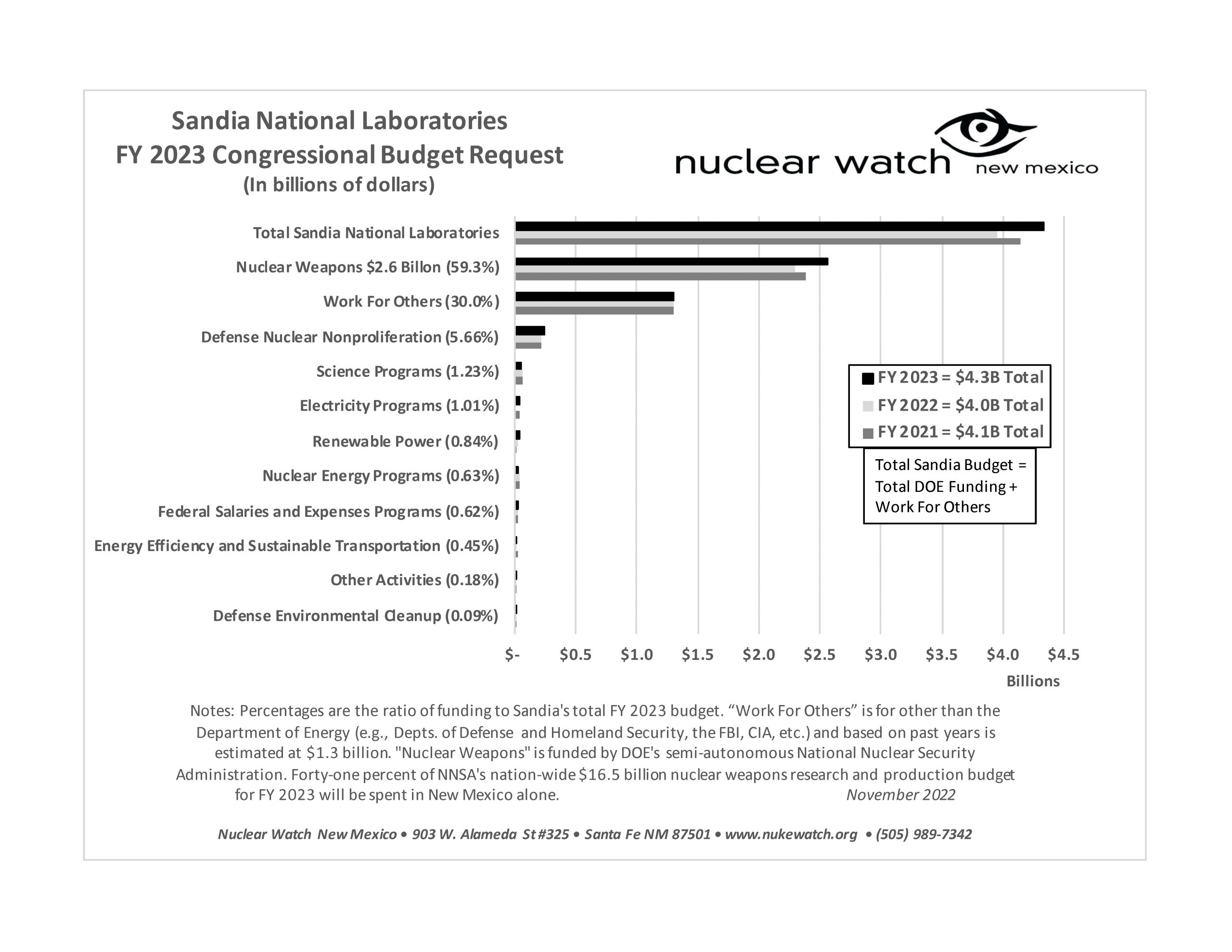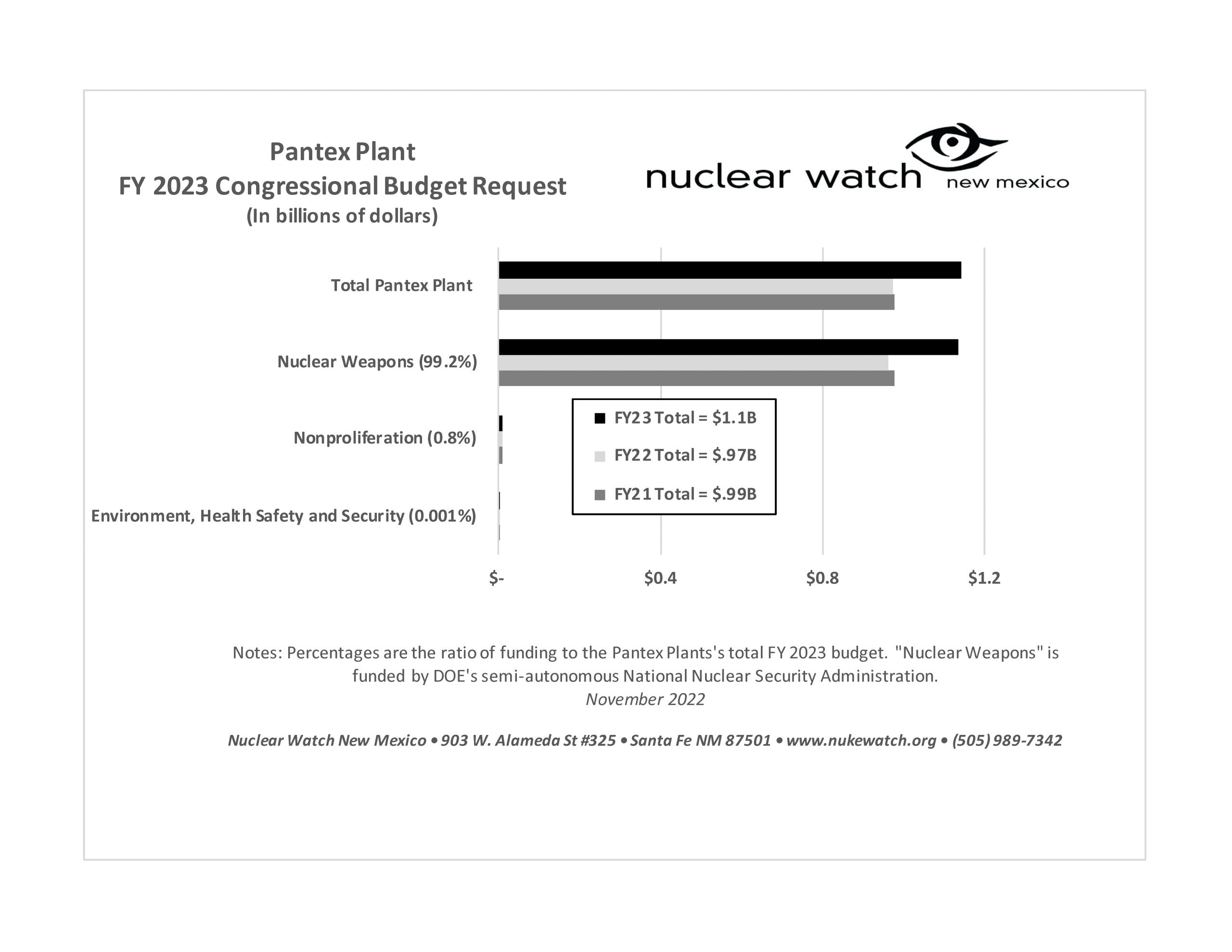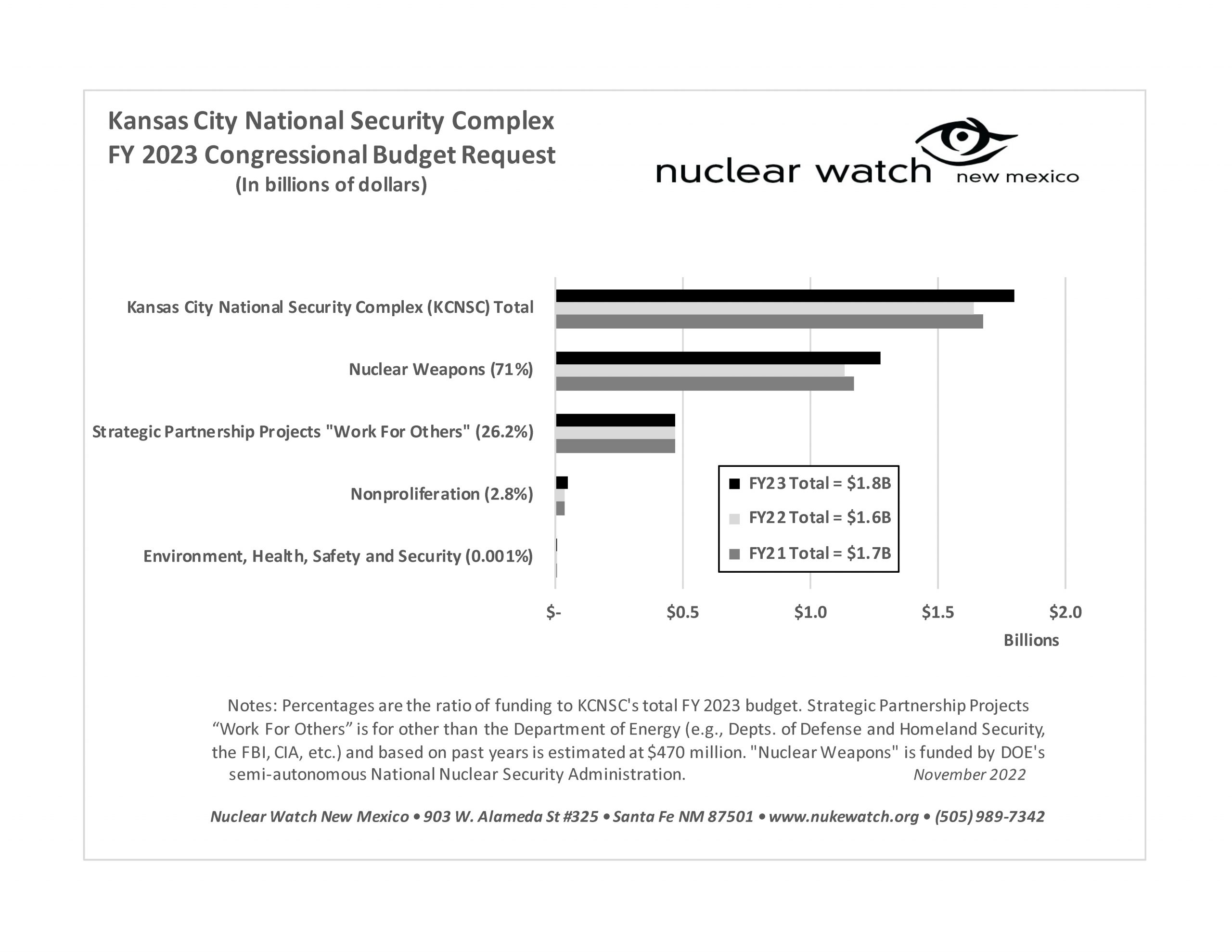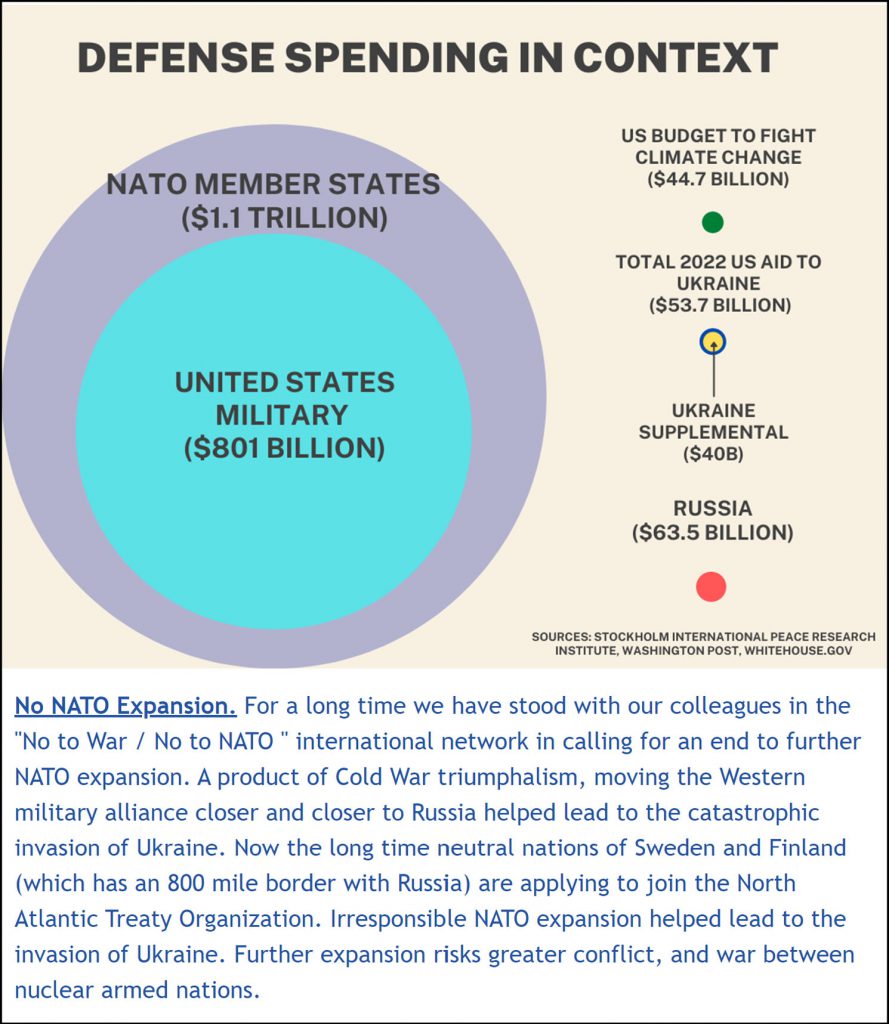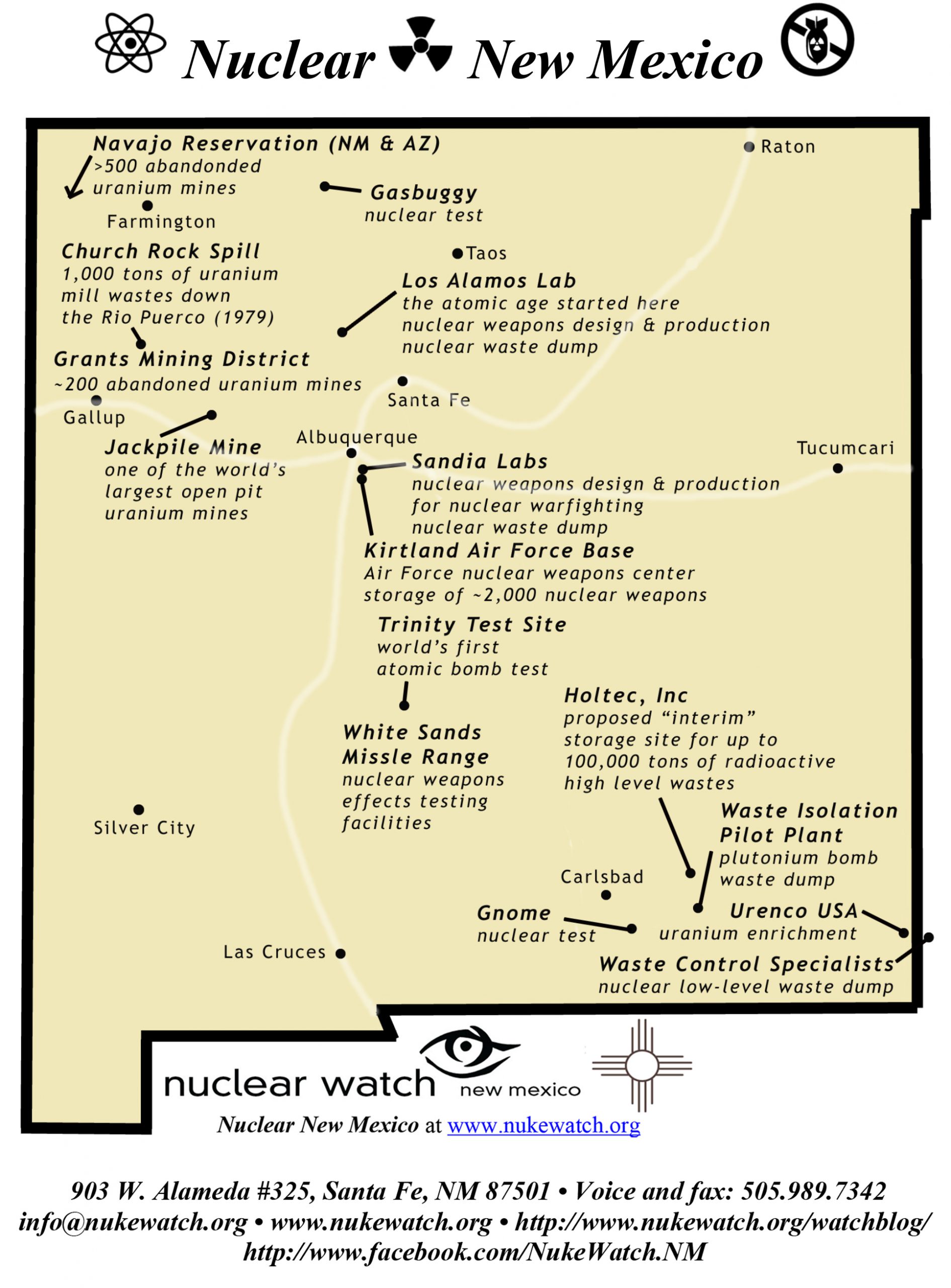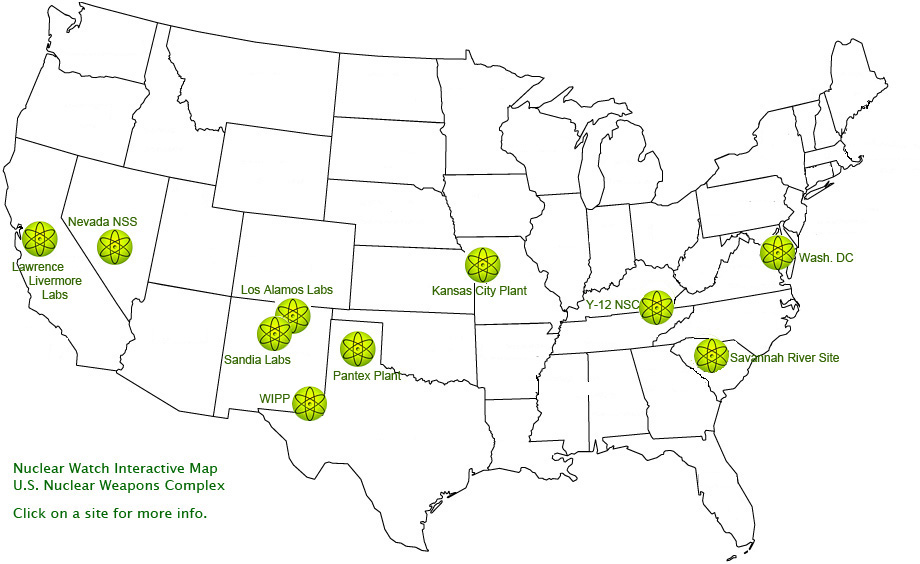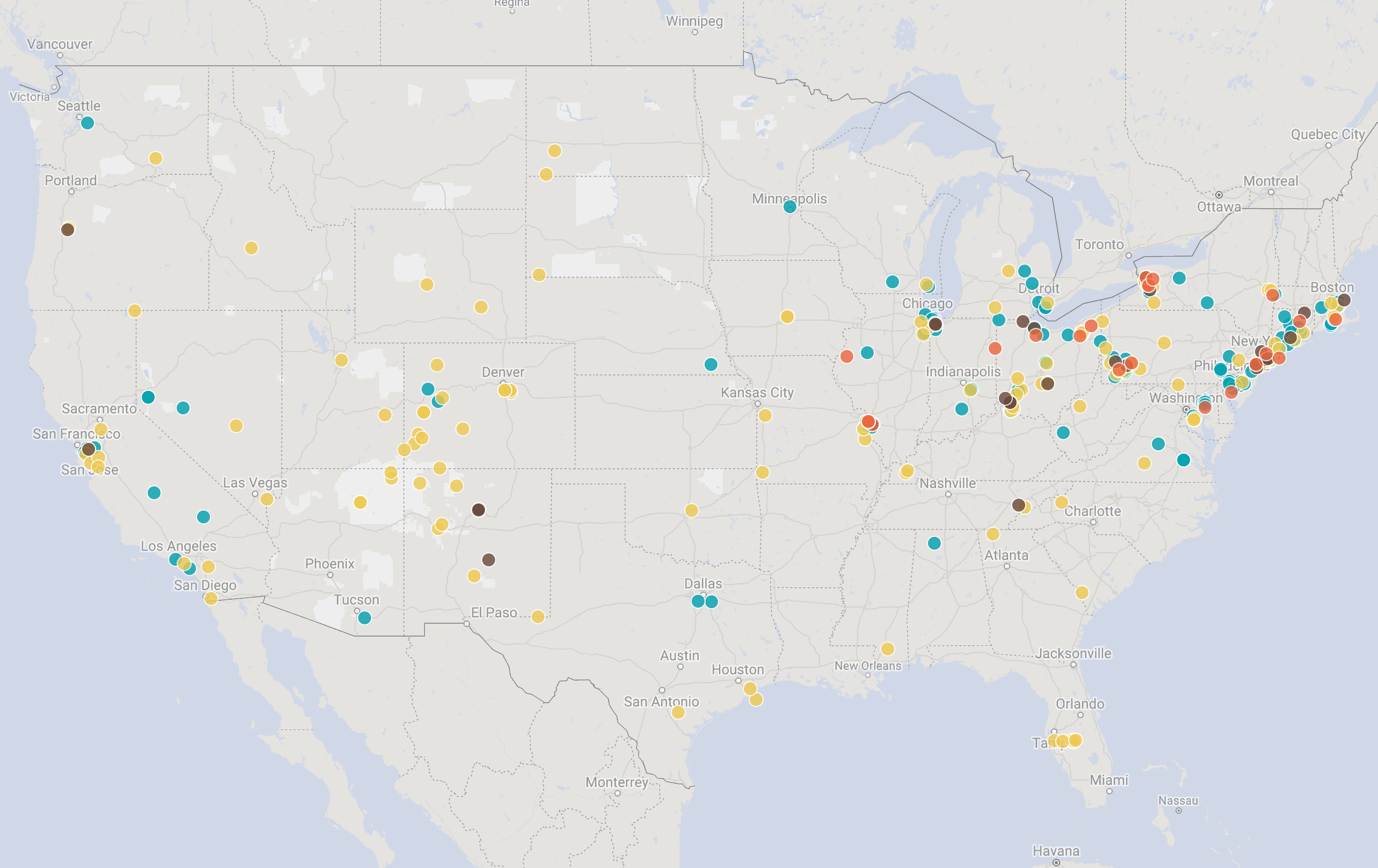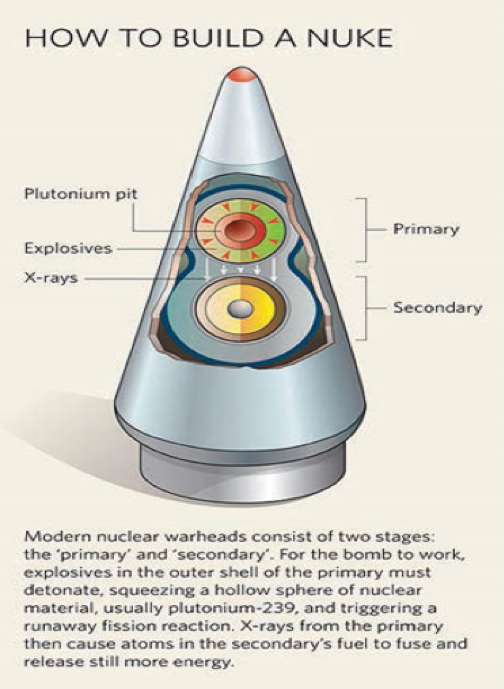QUOTE OF THE WEEK
Nothing Found
It seems we can’t find what you’re looking for. Perhaps searching can help.
LANL’s Central Mission: Los Alamos Lab officials have recently claimed that LANL has moved away from primarily nuclear weapons to “national security”, but what truly remains as the Labs central mission? Here’s the answer from one of its own documents:
LANL’s “Central Mission”- Presented at: RPI Nuclear Data 2011 Symposium for Criticality Safety and Reactor Applications (PDF) 4/27/11
Banner displaying “Nuclear Weapons Are Now Illegal” at the entrance in front of the Los Alamos National Lab to celebrate the Entry Into Force of the Nuclear Weapon Ban Treaty on January 22, 2021
Nothing Found
It seems we can’t find what you’re looking for. Perhaps searching can help.
Follow the Money!
Map of “Nuclear New Mexico”
Nuclear Watch Interactive Map – U.S. Nuclear Weapons Complex
In 1985, US President Ronald Reagan and and Russian President Mikhail Gorbachev declared that “a nuclear war cannot be won and must never be fought.”
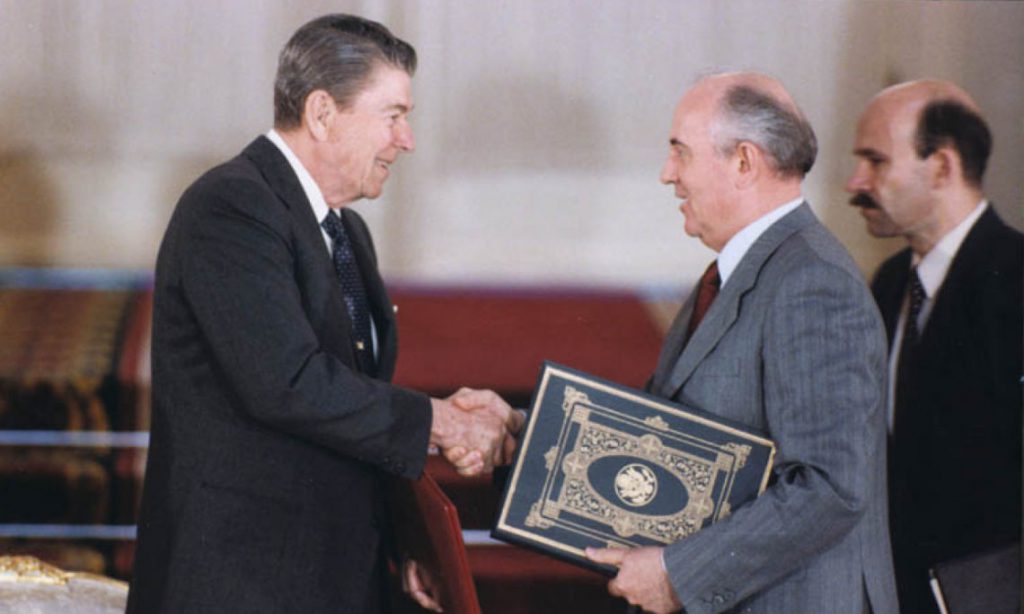
Waste Lands: America’s Forgotten Nuclear Legacy
The Wall St. Journal has compiled a searchable database of contaminated sites across the US. (view)
Related WSJ report: https://www.wsj.com
2022 BLOG POSTS
Nothing Found
It seems we can’t find what you’re looking for. Perhaps searching can help.
New & Updated
Plutonium Pit Production at LANL
Summary
Plutonium pit production is a chokepoint of resumed U.S. nuclear weapons production. Citizens have defeated four past government attempts to expand pit production. Now Trump promises to increase military spending, and Congress has already required expanded pit production at the Los Alamos Lab regardless of the technical needs of the stockpile. This will enable the continuing evolution of the U.S. nuclear weapons stockpile with new military capabilities. Trump’s pending federal budget will likely fund new and upgraded plutonium facilities expected to be operational for at least the next half-century. Continue reading
Costs Jump in Nuclear Weapons vs. Cleanup; Nuclear Weapons Winning over Environmental Protection
Santa Fe, NM.
America is at a crossroads, having to choose between an unnecessarily large, exorbitant, nuclear weapons stockpile, and cleanup that would protect the environment and water resources for future generations. Expanded nuclear weapons research and production, which will cause yet more contamination, is winning.
Two recently released government reports make clear the stark inequality between the so-called modernization program to upgrade and indefinitely preserve U.S. nuclear forces (in large part for a new Cold War with Russia), and the nation-wide program to clean up the radioactive and toxic contamination from the first Cold War. The Obama Administration launched a trillion dollar nuclear weapons “modernization” program, which President Trump may expand. In contrast, cleanup of the first Cold War mess has been cut from a high of $8.5 billion in 2003 to $5.25 billion in 2016, even though comprehensive cleanup would produce far more jobs than nuclear weapons programs.
As Trump Seeks to Expand U.S. Nuclear Weapons Capabilities New Sandia Labs Director Argued for Expanded Use of Nuclear Weapons
On December 22, 2016 president-elect Donald Trump upended four decades of U.S. policy to reduce nuclear weapons by tweeting “the United States must greatly strengthen and expand its nuclear capability until such time as the world comes to its senses regarding nukes.” The next morning he doubled down by declaring, “Let it be an arms race. We will outmatch them at every pass and outlast them all.”
That same day Russian President Vladimir Putin claimed that his country’s nuclear weapons are fully capable of penetrating any American missile defense system, and observed “It’s not us who have been speeding up the arms race.” Earlier Trump had suggested that Japan, South Korea and Saudi Arabia should perhaps obtain nuclear weapons, and reportedly asked a foreign policy advisor why the U.S. couldn’t use nuclear weapons if it already had them. Further, Trump refused to rule out using nuclear weapons in Europe or against the Islamic State in Iraq and Syria. Underlying all this is a trillion dollar effort begun under the Obama Administration to upgrade U.S. nuclear forces, including new nuclear weapons production plants, and new missiles, submarines and bombers, all expected to be operational until around the year 2080.
One of the most important players in the trillion dollar nuclear weapons upgrade is the Sandia National Laboratories, with its newly appointed director Stephen Younger. Long before Trump, Younger argued for the expanded use of nuclear weapons, writing in his June 2000 paper Nuclear Weapons in the 21st Century “[i]t is often, but not universally, thought that nuclear weapons would only be used in extremis, when the nation is in the gravest danger…..This may not be true in the future.” (P. 2)
Although generally the least publicly recognized of the three American nuclear weapons labs, Sandia is the largest by both budget and number of personnel (the other two nuclear weapons labs are the Los Alamos and the Lawrence Livermore National Laboratories). Sandia has multiple sites (hence is called “Labs” in the plural), but its main facility is on Kirtland Air Force Base in Albuquerque, NM. Nearby is the Kirtland Underground Munitions Maintenance and Storage Complex, likely the largest storage facility for nuclear weapons in the nation, with up to 2,500 warheads. Kirtland AFB also sites the Air Force’s national Nuclear Weapons Center, which describes itself as the “The Nucleus of America’s Deterrent”, whose stated mission is to “Deliver nuclear capabilities Warfighters use every day to deter and assure.”
Although “deterrence” has been sold to the American taxpayer for decades as the rationale for nuclear weapons, in reality the U.S. (and Russian) arsenal is for nuclear warfighting, as a 2013 top-level Pentagon document explicitly states:
The new guidance requires the United States to maintain significant counterforce capabilities against potential adversaries. The new guidance does not rely on a “counter-value’ or “minimum deterrence” strategy.
As one source explains
Counterforce doctrine, in nuclear strategy, [is] the targeting of an opponent’s military infrastructure with a nuclear strike. The counterforce doctrine is differentiated from the countervalue doctrine, which targets the enemy’s cities, destroying its civilian population and economic base. The counterforce doctrine asserts that a nuclear war can be limited and that it can be fought and won. https://www.britannica.com/topic/counterforce-doctrine
In turn, counterforce requires thousands of nuclear weapons for nuclear warfighting, instead of the few hundred needed for only deterrence. But as President Ronald Reagan famously put it in his 1984 State of the Union address:
A nuclear war cannot be won and must never be fought. The only value in our two nations possessing nuclear weapons is to make sure they will never be used. But then would it not be better to do away with them entirely?
In 1988 Reagan nearly reached agreement with Soviet Union leader Mikhail Gorbachev to ban nuclear weapons. Unfortunately, relying on false promises made by then-Livermore Lab Director Edward Teller, Reagan insisted on pursuing ballistic missile defenses (or “Star Wars”), which killed any possible deal. Thus, sadly, counterforce and the capability to wage a nuclear war remain the operative national security policy as we face today’s very real risk of entering into a new nuclear arms race with Russia.
Stephen Younger already foreshadowed this in his 2000 paper when he wrote, “The United States employs a counterforce strategy that targets military assets that could inflict damage to our national interests.” (P. 9) He is now in a prime position to implement that counterforce policy as Sandia Labs Director.
Sandia’s main mission is design of the thousands of nonnuclear components (such as fuzes, radars, etc.) that weaponize the nuclear designs of the Los Alamos and Lawrence Livermore National Laboratories into deliverable weapons of mass destruction. However, Sandia’s secondary mission is studying nuclear weapons “effects,” which are not the horrific effects of nuclear weapons on humans and the environment. Instead, this concerns the effects of nuclear weapons on nuclear weapons, to make sure that they are radiation hardened so that they will operate in the severe environments of a nuclear war. This is aimed at mostly the fratricidal effects of our own weapons, since any single target might be hit with multiple warheads. This has every thing to do with nuclear warfighting and first strike capabilities, rather than mere “deterrence.”
Younger’s appointment as director is also indicative of Sandia’s growing focus on nuclear weapons, principally due to Life Extension Programs (LEPs) that not only seek to indefinitely preserve existing nuclear weapons, but to also give them new military capabilities (Sandia is currently the lead lab for the B61-12 LEP, which is transforming a “dumb” bomb into the world’s first nuclear smart bomb). A decade ago Sandia Labs fell below 50% funded by nuclear weapons programs, which was publicly touted by the New Mexican congressional delegation as successful mission diversification leading to possible greater regional economic development. However, that trend is now reversed. In the FY 2017 federal budget request Sandia is 56% funded by nuclear weapons programs. In terms of gross funding for nuclear weapons programs Sandia is tied with the Los Alamos Lab at $1.58 billion for FY 2017, while Lawrence Livermore Lab’s nuclear weapons program is $1.07 billion. Sandia’s total annual budget is around $2.8 billion, the largest of the three nuclear weapons labs.
Jay Coghlan, Nuclear Watch New Mexico Director, commented, “Americans can’t allow an unpredictable president and a greedy nuclear weapons complex to fool us into a new nuclear arms race. Reagan said it best that “a nuclear war cannot be won and must never be fought.” We need to make sure that Trump gets that message as well. He says he wants to both rebuild the nation’s infrastructure and expand nuclear weapons capabilities. But it’s one or the other – Trump will find out the hard way that the country can’t afford to have it both ways.”
# # #
Stephen Younger’s June 2000 paper “Nuclear Weapons in the 21st Century” is available at https://nukewatch.org/importantdocs/resources/NuclearWeaponsIn21stCentury.pdf
For more on the Kirtland Air Force Base, the nuclear weapons complex within the nuclear weapons complex, please see https://nukewatch.org/Kirtland.html
The quote on U.S. nuclear weapons counterforce policy is from: Report on Nuclear Implementation Strategy of the United States Specified in Section 491 of 10. U.S.C. Department of Defense, June 2013, page 4 (quotation marks in the original) http://www.globalsecurity.org/wmd/library/policy/dod/us-nuclear-employment-strategy.pdf
As Trump Seeks to Expand U.S. Nuclear Weapons Capabilities New Sandia Labs Director Argued for Expanded Use of Nuclear Weapons
Santa Fe, NM
On December 22, 2016 president-elect Donald Trump upended four decades of U.S. policy to reduce nuclear weapons by tweeting “the United States must greatly strengthen and expand its nuclear capability until such time as the world comes to its senses regarding nukes.” The next morning he doubled down by declaring, “Let it be an arms race. We will outmatch them at every pass and outlast them all.”
One of the most important players in the trillion dollar nuclear weapons upgrade is the Sandia National Laboratories, with its newly appointed director Stephen Younger. Long before Trump, Younger argued for the expanded use of nuclear weapons, writing in his June 2000 paper Nuclear Weapons in the 21st Century “it is often, but not universally, thought that nuclear weapons would only be used in extremis, when the nation is in the gravest danger…..This may not be true in the future.” (P. 2)
Although “deterrence” has been sold to the American taxpayer for decades as the rationale for nuclear weapons, in reality the U.S. (and Russian) arsenal is for nuclear war-fighting, as a 2013 top-level Pentagon document explicitly states:
“The new guidance requires the United States to maintain significant counterforce capabilities against potential adversaries. The new guidance does not rely on a “counter-value’ or “minimum deterrence” strategy.”
Watchdogs Assail Revolving Door Between New Mexico Environment Department and Polluters
Nuclear Watch NM Press Release
For immediate release: January 17, 2017
Contact: Jay Coghlan, 505.989.7342, c. 505.470.3154, jay[at]nukewatch.org
Watchdogs Assail Revolving Door
Between New Mexico Environment Department and Polluters;
Gov. Martinez Fails to Protect State Budget and Environment
Santa Fe, NM – As the annual state legislative session begins, New Mexico is faced with a ~$70 million budget deficit, which must be balanced as per the state’s constitution, while revenues are projected to continue falling. To remedy this, Gov. Martinez plans to divert $120 million from public school reserves, take ~$12.5 million out of state employee retirement accounts, make teachers and state workers pay more into their retirement accounts (they are already among the lowest paid in the country), and extend 5.5% cuts for most state agencies while cutting yet more from the legislature and higher education. Instead, the state’s budget deficit could have been prevented had the New Mexico Environment Department aggressively fined polluters. But unfortunately there is a strong revolving door between NMED and the polluters it is suppose to regulate.
In her 2012 State of the State speech Gov. Martinez said, “My appointees are barred from lobbying state government for 2 years after serving in my administration.” Yet in August 2016 the Secretary of the New Mexico Environment Department (NMED), Mr. Ryan Flynn, resigned to become the Executive Director of the New Mexico Oil and Gas Association, whose main purpose is to lobby on behalf of the oil and gas industry against environmental regulations. Before joining NMED, Mr. Flynn worked for a law firm that advertises that “Our representation of oil and gas producers, mid-stream entities, and natural gas pipelines has been a mainstay of Modrall Sperling’s natural resources practice since the early days of the firm.” Modrall Sperling lawyers were very active in the NM Oil and Gas Association’s opposition to the so-called “pit rule” that sought to prevent oil and gas drilling mud waste from leaching into and contaminating groundwater. In June 2013 the New Mexico Oil Conservation Commission, appointed by Gov. Martinez, eviscerated the pit rule.
Similarly, Martinez and Flynn promulgated new groundwater protection rules that for the first time in the country actually allows groundwater contamination if it doesn’t migrate past the footprint of the operating site. This is the so-called Copper Rule, drafted by the copper mining giant Freeport-McMoRan (which is also a Modrell Sperling law firm client).
On January 13, 2017 Kathryn Roberts, the head of NMED’s Resource Protection Division, announced that she was leaving the Environment Department to accept an unnamed job in Alamogordo. Before NMED she worked at the Los Alamos National Laboratory (LANL) for four years as Group Leader for Regulatory Support and Performance (of “cleanup”). Upon information and belief, she will work as a public communications specialist for Longenecker and Associates, a Department of Energy (DOE) contractor that proposes to drill deep boreholes to test the disposal of high-level nuclear waste near Alamogordo.
This is part of the continuing targeting of New Mexico as the nation’s nuclear waste dump. Longenecker and Associates have participated in Sandia Labs studies of deep borehole high-level waste disposal. Of interest are some relatively recent new hires by Longenecker, including Don Cook, a longtime Sandia Labs scientist, past manager of the Atomic Weapons Establishment in the United Kingdom, and most recently the Deputy Administrator for Defense Programs (i.e., nuclear weapons) at the National Nuclear Security Administration. As such, he was essentially the head of the U.S. nuclear weapons complex, including the Los Alamos and Sandia Labs.
Also new to Longenecker and Associates as Corporate Vice President and Chief Strategy Officer is Christine Gelles, former interim manager of the new DOE Environmental Management field office at Los Alamos. A Longenecker resume´ notes that Gelles “Led planning and initial regulatory interactions with New Mexico Environment Department negotiation of Los Alamos Consent Order.” Ms. Roberts would have been one of Gelles’ counterparts on the other side of the table as head of NMED’s Resource Protection Division.
An original 2005 Consent Order negotiated between NMED and DOE was meant to compel comprehensive cleanup at LANL and force the Energy Department to increase cleanup funding. The new Consent Order, likely negotiated at least in part between Gelles and Roberts, contains giant loopholes whereby DOE can get out of cleanup by simply claiming that is too difficult or too costly. In fact, since the new Consent Order went into effect in June 2016, DOE has announced that the cost of “Remaining Legacy Cleanup” of radioactive and toxic wastes from more than 70 years of nuclear weapons research and production at LANL will cost $2.9 to $3.8 billion through fiscal year 2035, averaging $153 million per year, which is ridiculously low. That cost estimate clearly assumes that the Lab’s major radioactive and toxic wastes dumps will not be cleaned up. Instead they will be “capped and covered,” leaving some 200,000 cubic yards of radioactive and toxic wastes at Area G, its largest waste dump, posing a permanent threat to groundwater. DOE’s cost estimate for future LANL cleanup assumes flat funding out to FY 2035, and notes how that cost is “Aligned to [the] 2016 Consent Order.” This is a distinct and very unfortunate break from the 2005 Consent Order.
Particularly galling is the fact that under Gov. Martinez and ex-Secretary Ryan Flynn the New Mexico Environment Department granted more than 150 milestone extensions to the 2005 Consent Order, and then turned around and said that the Consent Order wasn’t working. From a budget perspective, New Mexico could have collected more than $300 million in stipulated penalties, more than four times the state’s projected budget deficit, had NMED vigorously enforced the 2005 Consent Order.
[For more, see here]
All of this is part of a pattern where the Martinez Administration has coddled the nuclear weapons industry even as that industry is cutting cleanup funding and ramping up nuclear weapons production that caused the mess to begin with. Gov. Martinez and ex-NMED Secretary Ryan Flynn have touted what they call an historic $74 million settlement that New Mexico and DOE reached after a radioactive waste barrel that LANL improperly treated ruptured at the Waste Isolation Pilot Plant (WIPP), contaminating 21 workers and closing down that multi-billion dollar facility for nearly three years. What was left unsaid is that DOE was already responsible for the supermajority of “Special Environmental Projects” that were agreed to in lieu of penalties and fines that could helped solved New Mexico’s budgets woes, even though state and federal policy on those projects both require that the regulatory agency collect a significant monetary penalty.
Not one penny went to New Mexico, while DOE was “obliged” to, for example, repave roads at WIPP and LANL that it uses to transport the radioactive bomb waste that it produces. To add insult to injury, NMED agreed to waive penalties for all future, unknown violations – no matter the severity or length – as long as there is corrective action of any sort at some undefined time. Also included in this give-away was an obligation by NMED to negotiate modifications to the 2005 Consent Order (now completed to New Mexico’s disadvantage), and to forego penalties that could have been assessed against DOE under it.
Jay Coghlan, Nuclear Watch New Mexico Director, commented, “It seems that the Environment Department under Gov. Martinez is in the business of protecting business against environmentalists. The legislature should hold their feet to the fire so that New Mexicans have a real environment department that protects our precious water resources and creates jobs doing so.”
# # #
Watchdogs Assail Revolving Door Between New Mexico Environment Department and Polluters; Gov. Martinez Fails to Protect State Budget and Environment
Santa Fe, NM
As the annual state legislative session begins, New Mexico is faced with a ~$70 million budget deficit, which must be balanced as per the state’s constitution, while revenues are projected to continue falling. To remedy this, Gov. Martinez plans to divert $120 million from public school reserves, take ~$12.5 million out of state employee retirement accounts, make teachers and state workers pay more into their retirement accounts (they are already among the lowest paid in the country), and extend 5.5% cuts for most state agencies while cutting yet more from the legislature and higher education. Instead, the state’s budget deficit could have been prevented had the New Mexico Environment Department aggressively fined polluters. But unfortunately there is a strong revolving door between NMED and the polluters it is suppose to regulate.
NNSA Releases Los Alamos Lab Performance Evaluation Report Nuclear Criticality Safety Issues Still Not Fully Resolved
Santa Fe, NM
The National Nuclear Security Administration (NNSA) has publicly released its fiscal year 2016 Performance Evaluation Report (PER) for Los Alamos National Security, LLC (LANS), the for-profit contractor that runs the Los Alamos Lab. The Performance Evaluation Report is NNSA’s annual report card on contractor performance, and overall the agency awarded LANS $59 million in profit out of a possible $65 million. The grade was 85% for the incentive part of the award. In 2012 Nuclear Watch New Mexico successfully sued NNSA to ensure that the Performance Evaluation Reports detailing taxpayers funds paid to nuclear weapons contractors are publicly available. In 2016 the NNSA decided to put the LANL management contract out for competitive bid, but granted LANS a contract extension until the end of September 2018.
Despite the passing grade that NNSA gave LANS, there is still ample reason for public concern. First, it bears repeating that in February 2014 a radioactive waste drum improperly prepared by the Los Alamos National Laboratory (LANL) burst underground at the Waste Isolation Pilot Plant (WIPP), contaminating 21 workers and closing that multi-billion dollar facility (a limited restart of operations at WIPP may occur this month).
Less widely known is the fact that LANL’s main plutonium facility that produces WIPP wastes has only recently restarted operations after being shut down since June 2013 because of nuclear criticality safety concerns…
Watchdog Groups Call For New Environmental Impact Study For Nuclear Bomb Plant
Cite Worker And Public Risks, New Seismic Information
“The Oak Ridge Environmental Peace Alliance and Nuclear Watch New Mexico today released a letter to Secretary of Energy Ernest Moniz calling for a new Site-Wide Environmental Impact Statement for the Y-12 Nuclear Weapons Complex in Oak Ridge, Tennessee. Y-12 is a manufacturing plant that produces the thermonuclear cores (secondaries) for US nuclear warheads and bombs.
“The letter rejects the analysis prepared by the National Nuclear Security Administration and the subsequent Amended Record of Decision released in August 2016 in which the NNSA gave itself the green light to proceed with construction of the Uranium Processing Facility, a bomb plant originally intended to replace aging facilities.”
Jay Coghlan, Nuclear Watch New Mexico Director, commented:
“The Uranium Processing Facility is the tip-of-the-spear for the trillion dollar “modernization” of U.S. nuclear forces that will fleece the American taxpayer. It will enrich the usual fat cat defense contractors by keeping nuclear weapons forever while rebuilding them to give them new military capabilities. The public has the legal right to review planned changes to the deeply troubled Uranium Processing facility, which we seek to enforce.”
See Also: Letter To Senator Moniz
Energy Dept Misrepresents Cost and Scope of Los Alamos Cleanup
New Mexican Politicians Should Not Be Misled
Energy Dept Misrepresents Cost and Scope of Los Alamos Cleanup
Santa Fe, NM – The Department of Energy (DOE) has released a 2016 Lifecycle Cost Estimate Summary of proposed future cleanup at the Los Alamos National Laboratory (LANL). At the beginning of that document DOE declares that “An estimated 5,000 cubic meters of legacy waste remains, of which approximately 2,400 cm [cubic meters] is retrievably stored below ground”, a claim which was widely reported in New Mexican media. From there DOE estimates that it will cost $2.9 to $3.8 billion to complete so-called cleanup around 2040.
The public was notified of the 2016 Lifecycle Cost Estimate in a September 15 Santa Fe City press release, with the subtitle “Study Lays Out Timeline, Costs, and More, Answers Critical Questions with Honest Assessment.” Santa Fe Mayor Javier Gonzales is quoted, “This report represents the first and most comprehensive release of specific plans to complete the cleanup of legacy waste at LANL, and is a big step forward for the people in these communities who want to see a concrete commitment to making progress.” Mayor Gonzales went on to thank Senators Udall and Heinrich and Rep. Ben Ray Lujan for their help in obtaining the report.
However, the DOE report is far from honest. It intentionally omits any mention of approximately 150,000 cubic meters of poorly characterized radioactive and toxic wastes just at Area G (LANL’s largest waste dump) alone, an amount of wastes 30 times larger than DOE acknowledges in the 2016 Lifecycle Cost Estimate. In reality, DOE and LANL plan to not clean up Area G, instead installing an “engineered cover” and leaving the wastes permanently buried. This will create a permanent nuclear waste dump above the regional groundwater aquifer, three miles uphill from the Rio Grande. Radioactive and toxic wastes are buried directly in the ground without liners, and migration of plutonium has been detected 200 feet below Area G’s surface.
Santa Fe Mayor Gonzales is the Vice-Chair of the Regional Coalition of LANL Communities. The Coalition is comprised of elected official from eight cities, counties and pueblos surrounding LANL, and is overwhelmingly funded by DOE and Los Alamos County. The same Santa Fe City press release quotes the RCLC Executive Director, “The Lifecycle Baseline documentation provides our communities the necessary foundation to properly advocate on behalf of the best possible scenarios for cleaning up legacy nuclear waste at the Laboratory in the most time and cost-efficient manner. After years of requests for this document, we now have the tool that can get us to additional cleanup dollars to get the job done.”
However, the 2016 Lifecycle Cost Estimate Summary itself states that it is “based on realistic expectations of annual funding for the remaining work” (last page, unnumbered) and “annual funding is expected to remain constant throughout the duration of the cleanup mission” (p. 5). While annual funding for the Lab’s nuclear weapons programs has climbed to $1.5 billion, cleanup has fallen from a high of $225 million in FY 2014 to $189 million requested for FY 2017. Moreover, this trend of declining cleanup funding may be exacerbated by the planned trillion dollar “modernization” of U.S. nuclear forces, including research and production sites like LANL (which is slated to quadruple production of the plutonium pit triggers for nuclear weapons). Instead of being a tool for additional dollars for genuine, comprehensive cleanup, the 2016 Lifecycle Cost Estimate Summary is a DOE ploy to avoid cleaning up more than 90% of all wastes at LANL.
Jay Coghlan, Nuclear Watch New Mexico Executive Director, commented, “Mayor Gonzales and the Regional Coalition are to be commended for getting any Lab cleanup plan at all out of the Department of Energy. But now they should take the next step and get the Department of Energy to quit being so chintzy with cleanup. Our elected officials should demand that DOE retract its false claim that there is only 5,000 cubic meters of waste left at LANL to clean up. Then our politicians should push hard for a genuine, comprehensive cleanup plan that permanently protects the environment and our precious water resources while creating hundreds of high paying jobs.”
# # #
The Department of Energy’s 2016 Lifecycle Cost Estimate Summary is available at https://nukewatch.org/importantdocs/resources/LBC-Summary-Aug-2016.pdf
Estimated quantities of waste at Area G (in cubic yards) are from Table G3.41, MDA G Corrective Measures Evaluation, 2011, LANS, p. G-13. See excerpts at https://nukewatch.org/importantdocs/resources/Area_G_Pit_Totals_from_CME_rev3_Sept-2011.pdf
The full MDA G Corrective Measures Evaluation (159 MB) is available at http://permalink.lanl.gov/object/tr?what=info:lanl-repo/eprr/ERID-206324
Documentation of the plutonium detection 200 feet below the surface of Area G is at https://nukewatch.org/importantdocs/resources/AGCME Plate_B-3_radionuclides_subsurface.pdf

New Mexican Politicians Should Not Be Misled- Energy Dept. Misrepresents Cost and Scope of Los Alamos Cleanup
Santa Fe, NM
“…The DOE report is far from honest. It intentionally omits any mention of approximately 150,000 cubic meters of poorly characterized radioactive and toxic wastes just at Area G (LANL’s largest waste dump) alone, an amount of wastes 30 times larger than DOE acknowledges in the 2016 Lifecycle Cost Estimate. In reality, DOE and LANL plan to not clean up Area G, instead installing an “engineered cover” and leaving the wastes permanently buried. This will create a permanent nuclear waste dump above the regional groundwater aquifer, three miles uphill from the Rio Grande. Radioactive and toxic wastes are buried directly in the ground without liners, and migration of plutonium has been detected 200 feet below Area G’s surface…”
New Mexican Politicians Should Not Be Misled- Energy Dept. Misrepresents Cost and Scope of Los Alamos Cleanup
Santa Fe, NM
The Department of Energy (DOE) has released a 2016 Lifecycle Cost Estimate Summary of proposed future cleanup at the Los Alamos National Laboratory (LANL). At the beginning of that document, DOE declares that “An estimated 5,000 cubic meters of legacy waste remains, of which approximately 2,400 cm [cubic meters] is retrievably stored below ground”, a claim which was widely reported in New Mexican media. From there DOE estimates that it will cost $2.9 to $3.8 billion to complete so-called cleanup around 2040.
DOE Secretly Funding Front Group to Help it Evade Nuclear Cleanup
FOR IMMEDIATE RELEASE: August 31, 2016
Contact: Denise Duffield, 213-689-9170 <tel:213-689-9170> office
Cindi Gortner 818-489-1226
Bonnie Klea 818-854-4825
Marie Mason 805-279-0356
U.S. Department of Energy Secretly Funding Front Group to Help it Evade Nuclear Cleanup at Santa Susana Field Laboratory
Controversial grant made at the same time department reneged on financial commitment to national independently administered community fund
Community members living near the contaminated Santa Susana Field Laboratory were outraged to learn that the U.S. Department of Energy (DOE) has secretly been funding a front group that is lobbying for the breach of DOE’s cleanup agreement for the Santa Susana Field Laboratory (SSFL) – and that the agency’s request for secrecy may have been made to avoid attention from Senator Barbara Boxer, a longtime supporter of full cleanup.
SSFL is heavily contaminated with nuclear and chemical contamination resulting from decades of nuclear activities and rocket engine testing, In 2010, agreements (Administrative Orders on Consent or AOCs) were signed between the state Department of Toxic Substances Control (DTSC) and DOE and NASA to cleanup all detectable contamination at their respective portions of the property. The AOC was first proposed by former DOE Secretary Dr. Steven Chu and Assistant Secretary for Environmental Management (DOE-EM) Dr. Inez Triay. Boeing, which owns most of the site, refused to sign the agreement and is pushing for a much weaker cleanup.
In 2011, under the Brown Administration, the DTSC’s commitment to full cleanup began to erode, and along with it, those of NASA and DOE. Over objections from community members and elected officials , the DTSC replaced the longstanding public participation vehicle, the SSFL Work Group, with the SSFL Community Advisory Group (SSFL CAG). The CAG’s leadership is composed of individuals with ties to the parties responsible for the contamination at SSFL, and the group actively lobbies against the AOCs. One CAG flyer reads, “Why the AOC Cleanup at SSFL is Bad for Our Community” (here .) and states that the AOC will harm the environment and Native American artifacts, which are in fact protected by the AOC. The CAG also denies SSFL’s health impacts. One CAG member, a former SSFL official and current DOE contractor, maligned previous health studies so badly that their authors felt compelled to write an op-ed in the Ventura County Star in defense.
The public has been demanding to know for a long time how the CAG was funded, and neither the CAG nor DTSC have disclosed that information. In December 2015 and in May 2016 , cleanup advocates complained to the DTSC Independent Review Panel (IRP), established by the California legislature to investigate DTSC’s many failings, about the CAG’s anonymous funding and conduct. No action was taken on the matter.
The complaints were instigated by the CAG’s announcement, at it’s August 19, 2015 meeting, that it would be receiving a $32,000 – $35,000 donation from a donor who wished to be anonymous. A video from the meeting shows CAG member Alec Uzemeck claiming the donation had “no strings,” and that it was anonymous “Because everything we do is politically charged. We have people out there who make phone calls. And if you’re the executive of a corporation and you get a call from Barbara Boxer, I’m quite sure that that’s going to have an impact on it. But, we don’t want that. We wanna have the money in hand when we announce who the donors are.” (See video here .) The CAG’s August 2015 minutes (here ) make it clear that the anonymity was at the donor’s request, and so secret that the CAG leadership would not reveal the donor to the full CAG membership, causing one CAG member to resign.
At it’s August 17, 2016 meeting, a full year after having announced its anonymous gift, the CAG revealed that the donor was the Department of Energy. Uzemeck said, “DOE will be coming out with a quarterly report, probably in two or three weeks. And it will have a list of grants on the last page. And DOE is the one that made the grant for us. They are the one who supplied the funding. So, the question’s been answered.” Uzemeck’s statement can be viewed here. The CAG’s tax returns show that the organization received $38,600 in 2015.
The DOE refuses to answer questions about the arrangement, what the grant funds are expended on, explain why the funding was kept secret for a full year, or provide a copy of the grant application and contract. “For one of the Responsible Parties, DOE, to be funding a group that is trying to help DOE avoid its cleanup obligations, and asking for DOE’s identity as the source of the funds to be long kept secret, would be nothing short of scandalous.” said Denise Duffield, Associate Director of Physicians for Social Responsibiiity-Los Angeles in an August 30 email to Dr. Monica Regalbuto, Assistant Secretary for the DOE’s Office of Environmental Management.
Community members are also deeply troubled that DOE funded the CAG during the same month that it broke its commitment and revoked funding for the final year of a five-year commitment to the New Mexico Community Foundation (NMCF)-administered Community Involvement Fund (CIF), which funds independent groups in impacted communities near contaminated DOE sites throughout the country. Reneging on its contract and failing to disperse a final $300,000 payment to NMCF caused over a dozen community groups to lose key funding.
“DOE broke its commitment to provide its funding for community groups near contaminated sites through an independent mechanism and hands-off procedures that assured DOE would not do precisely what it has now done—fund a front group to lobby on DOE’s behalf to get out of its cleanup obligations.” said Duffield in the email to Regalbuto.
Community members are dismayed and angered by the revelations. Simi Valley resident Marie Mason, who has led community cleanup efforts for 28 years, said, “I find it more than shocking that the DOE would fund this group and ask to conceal they are the funding source and especially to not have Senator Boxer find out. I am more than disgusted and filled with sadness. DOE and DTSC are part of the problem with too many close ties to the polluters and total disregard for the communities they are supposed to protect.”
Bonnie Klea, a former worker at SSFL and cancer survivor, said, “I am appalled that DOE funded the CAG so that members can go out and lobby against the AOC and deny the cancer risks from the past, present and future exposure from the site. This is disgusting. ” Klea and others note that the CAG does not represent the views of the community, which overwhelming supports the AOCs. All but 14 of the 3,700 comments submitted on the AOC were in favor of the agreement, and over 1,600 signed a petition last year urging that the cleanup agreements be upheld. (See petition here .)
Duffield’s email to DOE, sent also to local and state officials, implored the agency for answers and noted that no local elected officials had been consulted with or informed of the funding. “The community has the right to know about the intent, character, and tactics of the agency that holds their potential health and well being in its hands. And elected officials, many of whom have been lobbied by the CAG to weaken the cleanup, must be informed about financial contributions that DOE is making to this group to influence them and help it break out the cleanup agreements.”
# # #
The Rocketdyne Cleanup Coalition, or RCC, is a community-based alliance dedicated to the cleanup of the Santa Susana Field Laboratory (SSFL), commonly known as Rocketdyne.
From: Denise Duffield <dduffield(at)psr-la.org>
Date: Mon, Aug 29, 2016 at 12:57 PM
Subject: Time-Sensitive Request re: DOE CAG funding and the SSFL AOC cleanup agreement
To: monica.regalbuto@em.doe.gov
Dear Assistant Energy Secretary for Environmental Management Regalbuto:
I was shocked to learn recently that DOE has been funding a front group that is lobbying for the breach of DOE’s cleanup agreement for the Santa Susana Field Laboratory (SSFL) – and that DOE had apparently requested that the funding be kept secret so that Senator Barbara Boxer wouldn’t learn of it. I write today to both apprise you of this troubling situation and to request further information and documents related to DOE’s decision to fund the SSFL CAG.
The SSFL CAG is a small but highly controversial group that is lobbying against the cleanup agreement (Administrative Order on Consent, or AOC) for SSFL signed by both DOE and the state regulatory agency overseeing the cleanup, the Department of Toxic Substances Control (DTSC). For example, one CAG flyer reads, “Why the AOC Cleanup at SSFL is Bad for Our Community” (here.) “The AOC Cleanup: More Harm Than Good?” reads another (here.) The CAG routinely propagates false information about SSFL’s contamination, health impacts, and cleanup. A CAG – Community Advisory Group – should represent the community. However, the SSFL CAG does not even remotely represent the community, which understands that SSFL is contaminated with dangerous radionuclides and chemicals and needs to be fully remediated per the current DOE cleanup agreement. The CAG is a classic “astroturf” (i.e., fake grassroots) group dominated by people with ties to the parties responsible for the contamination at SSFL.
The public has been demanding to know for a long time how the CAG was funded and how it spends those funds. The CAG has refused to disclose that information, which is troubling for an entity that claims to be public. The community has suspected that the money comes from one or more of the entities that polluted the site and that is trying to get out of its cleanup obligations, and that that is why the CAG wouldn’t disclose the funding source or sources. Now it appears that that is indeed the case. For one of the Responsible Parties, DOE, to be funding a group that is trying to help DOE avoid its cleanup obligations, and asking for DOE’s identity as the source of the funds to be long kept secret, would be nothing short of scandalous.
The DOE SSFL cleanup agreement (AOC) was proposed by former DOE Secretary Dr. Steven Chu and Assistant Secretary for Environmental Management (DOE-EM), Dr. Inez Triay. It was signed by DOE and DTSC in December 2010. The AOC stipulates that Area IV and the Northern Buffer Zone at SSFL are to be cleaned up to background. In February 2014, at a meeting of the SSFL Work Group, DOE SSFL Project Director John Jones told the audience of community members, elected officials, and media that the DOE was committed to upholding the AOC agreement (see video here.)
Since then, the community has seen an erosion of DOE’s stated commitment, including a Public Scoping plan which included numerous options that would violate the AOC (such as keeping waste on site), accompanied by a report grossly exaggerating soil removal estimates (see statement by the Southern California Federation of Scientists here.) In addition, the AOC explicitly defines soils as including structures (see page five of AOC here), which are to be cleaned up to background and all wastes to go to licensed low level radioactive waste disposal sites, yet DOE is now taking the position that it can demolish nuclear structures at SSFL at will, using far less protective standards, and dispose of their radioactive wastes anywhere. The DOE has also apparently told the CAG that it is contemplating trying to modify the AOC to be required to perform much less cleanup than it had promised in order to save money (see CAG July 20, 2016 minutes here.)
And now, we have learned that the DOE has been funding the CAG. The DOE is abundantly aware that the CAG openly, actively, and vigorously works to break the AOC cleanup agreement that DOE signed. DOE’s funding of the SSFL CAG is therefore an alarming and direct assault on the AOC itself. It also makes clear that the CAG is an agent of one of the parties responsible for the pollution at the site and which is trying desperately to get out of its obligation to clean up all the radioactive and toxic mess that it made. The CAG regularly lobbies elected officials to try to persuade them to push to weaken the cleanup —an activity outside the scope of a regular community advisory group. It is very troubling for DOE, responsible for the contamination and sworn to uphold a cleanup agreement to clean it all up, to be secretly funding a group that lobbies elected officials to support DOE breaking its agreement.
We are also deeply disturbed by the secrecy surrounding DOE’s grant to the SSFL CAG. The CAG first announced that it was to receive $32,000 in funding at an August 2015 meeting, in which it stated that the donor wished to remain anonymous in order to avoid Senator Barbara Boxer, a longtime SSFL cleanup supporter, learning of the funding and taking action thereon. (See video of CAG meeting here.) Only now, a year later, near the end of Senator Boxer’s esteemed Senate career, has the CAG apparently been given permission to reveal that the identity of its funder is the DOE. It is outrageous and unconscionable for a government agency to make a financial contribution to any organization and request that the funding be kept secret, for any reason, let alone for the purpose of evading the attention of a United States Senator who would likely object to what it was doing. The CAG’s August 2015 minutes (here) make it clear that the anonymity, which lasted a full year, was at the donor’s request.
Further, the DOE funded the CAG during the same year that it broke its commitment and revoked funding for the final year of a five-year commitment to the New Mexico Community Foundation (NMCF)-administered Community Involvement Fund (CIF), which funds independent groups in impacted communities near contaminated DOE sites throughout the country. The DOE’s agreement with NMCF states, “By utilizing a cooperative agreement with an independent entity to distribute grant funds to qualified organizations representing the interests of the public, DOE-EM will ensure that the program is not viewed as a surrogate for DOE’s own preferences, and that long-term DOE-EM decisions are based on input from individuals and/or groups who are most likely to be affected by those decisions.”
In other words, DOE was supposed to stay out of the grant selection process to assure that groups funded were independent of DOE. However, the DOE weighed in heavily against a re-application submitted by Physicians for Social Responsibility-Los Angeles (PSR-LA) for the SSFL Work Group, the longstanding advisory group established a quarter of a century ago by the electeds and which represents the main mechanism for the community to learn about and provide feedback on the cleanup and hold the agencies accountable. In August 2013 we applied for and received a $23,000 CIF grant. We re-applied in August 2014, but learned that DOE was pressuring CIF to deny the grant, which violated its commitment to keep hands-off the selection process. To its credit, in November 2014, the NMCF awarded the second grant of $20,000 (and did not fund the SSFL CAG, which had also applied for the funding.)
Very shortly thereafter, the DOE reneged on the final $300,000 it had pledged to NMCF, impacting not just PSR-LA and the SSFL Work Group but over a dozen communities nationwide. NMCF sent a message to its grantees on March 16, 2015 stating, “Earlier this year, representatives of the Department of Energy (DOE) advised New Mexico Community Foundation (NMCF) that the foundation would receive only partial funding for the CIF grant program in 2015. Last month, we were informed that NMCF would only be funded a small portion of the overall budget request solely for administrative oversight of the current 2014-15 grant cycle, and no funding would be allocated to go towards new grant-making. Adding to our confusion and concern, the decision-making process associated with the 2015 CIF appropriation has not been clearly communicated, nor have we been given a clear indication of the reasons for the reduction in funding.”
We cannot say with certainty that DOE revoked funding to the NMCF due to its decision to fund the SSFL Work Group despite the inappropriate pressure by DOE. But, we must point this out as a strong possibility in light of the timing and DOE actions described herein. The CIF grant enabled the return of the trusted public participation vehicle, the SSFL Work Group, which attracted capacity crowds who were able to learn about the contamination that would be left on site if the cleanup agreements were not upheld. DOE had participated in the SSFL Work Group since its inception, but has now stopped attending virtually any public meeting where it could be held to account for its actions. Regardless of DOE’s motivation to abrogate its agreement with NMCF, it is very troubling that the DOE made this decision while simultaneously funding an organization that opposes a cleanup agreement that the DOE has been strongly signaling it wants to break. DOE broke its commitment to provide its funding for community groups near contaminated sites through an independent mechanism and hands-off procedures that assured DOE would not do precisely what it has now done—fund a front group to lobby on DOE’s behalf to get out of its cleanup obligations.
It is difficult to overstate just what is at stake for communities near SSFL right now. Decades of nuclear and aerospace activities at SSFL have left a legacy of dangerous nuclear and chemical contamination that continues to migrate from the site to offsite populations. Federal studies have shown an increase in cancers associated with proximity to the site. In 2010, after decades of attempts to achieve full cleanup, the historic AOCs were signed. As a result, $41.5 million dollars were spent for a US EPA survey that identified background radiation and found nearly 500 samples, in just one area of SSFL, that were above background, in some cases dramatically so. The community eagerly anticipated full cleanup, which the AOC stipulated would be complete by 2017.
We are now just months away from 2017, but cleanup has yet to begin. Indeed, DOE’s draft EIS – which a court ordered a decade ago and was due to be published years ago – is not yet released. Community members have feared that DOE’s EIS would be a full-bodied attack on the very cleanup agreement DOE had sworn to carry out, and wondered if the EIS was being delayed so as to not come out until after Senator Boxer leaves office and can no longer take action to insist DOE live up to the promises made. This suspicion has only increased given the timing of the announcement that DOE is the CAG’s secret benefactor, and that the reason for the secrecy was to avoid attention from Boxer. The community is appalled and angry, and deserves to know the full details of DOE’s arrangement with the SSFL CAG.
Below please find background information and documentation on these matters, followed by a series of pressing questions. I request that DOE provide answers to the questions, as well as a copy of the SSFL CAG Foundation’s grant application/proposal to the DOE and its DOE grant/contract, as well as any grant report, immediately. If there has been more than one grant to the CAG, provide information about each. The community has the right to know about the intent, character, and tactics of the agency that holds their potential health and well being in its hands. And elected officials, many of whom have been lobbied by the CAG to weaken the cleanup, must be informed about financial contributions that DOE is making to this group to influence them and help it break out the cleanup agreements. DOE funding a front group to lobby elected officials to push them to support DOE breaking its cleanup agreements would be an outrage.
Background and Documentation
The SSFL CAG was formed in 2012 over the objections of longtime community members and local elected officials. (See community petition here and letter from elected officials Julia Brownley, Fran Pavley, Shelia Kuehl, Linda Parks, and Greig Smith opposing formation of the CAG and supporting instead the longstanding SSFL Work Group here.) The CAG is widely perceived as a front group for the polluters that does not represent the interests of the community, because it is opposes the cleanup agreements that are overwhelming supported by the community. All but a handful of the 3,700 comments submitted on the AOC were in favor of the agreement. Last year over 1,600 signed a petition urging that the cleanup agreements be upheld. (See petition here.) Yet every member of the CAG opposes the AOCs, despite the requirements that a CAG represent the range of community perspectives.
The CAG’s leadership is composed of individuals who are former employees or contractors of the parties responsible for cleaning up the site (Boeing, DOE, and NASA.). Alec Uzemeck worked for Boeing’s predecessor, North American Aviation, at its then-headquarters in Downey for which the Santa Susana site was the field lab. Brian Sujata was Boeing’s project manager for SSFL cleanup, while Boeing was DOE’s contractor for the cleanup. Ross Berman worked for both Tetra Tech and CH2M Hill, contractors for the responsible parties. And Abe Weizberg was an official at SSFL, in charge of safety for the SNAP reactors, one of which experienced 80% fuel damage in an accident. Weitzberg remains a consultant for the DOE.
Since its founding, the SSFL CAG has undertaken a multi-faceted campaign aimed at undoing the SSFL cleanup agreements. This includes exaggerating cleanup soil volumes and truck traffic and claiming that the cleanup will harm the site’s natural environment and Native American artifacts (which are in fact protected by the AOC.) The CAG also attempts to minimize the contamination at SSFL and health impacts. Last year, CAG member and former SSFL official Weitzberg launched an effort to have the Agency for Toxic Substances and Disease Registry (ATSDR) refute prior health studies and weigh in against the cleanup. In the process, he maligned the authors of those studies, who expressed their objections in an article published in the Ventura County Star here. The CAG has also made a habit of regularly and publicly disparaging longtime community members and cleanup advocates. Whereas meetings of the longstanding SSFL Work Group are packed with concerned members of the public and representatives of elected officials, very few attend CAG meetings. The last meeting had only half a dozen CAG members and a roughly equal number of the public, most of whom were critics of the CAG’s biases and actions.
On August 19, 2015, CAG member Alec Uzemeck announced at an SSFL CAG meeting that the CAG would be receiving a $32,000 – $35,000 donation from a donor who wished to be anonymous. The minutes from the meeting (which can be viewed here) state that the CAG established a non-profit foundation, “…in response to the gift from a donor who wishes to remain anonymous.” The CAG leadership was so secretive about the donor’s identify that it refused to inform the full CAG membership, causing one CAG member to resign, as reflected in the minutes, ” As a result of the fact that the donor is anonymous, Elizabeth Harris has resigned from the CAG…” At the meeting, Uzemeck repeatedly said that the donation had “no strings,” and of the gift said, “Why is it anonymous at this point? Because everything we do is politically charged. We have people out there who make phone calls. And if you’re the executive of a corporation and you get a call from Barbara Boxer, I’m quite sure that that’s going to have an impact on it. But, we don’t want that.” (See video here.)
In December 2015 and in May 2016, cleanup advocates and community members complained to the DTSC Independent Review Panel (IRP), established by the California legislature to investigate DTSC’s many failings, about the CAG’s anonymous funding and conduct (see paragraphs 4 -6 on page 2 of the IRP’s May 12, 2016 minutes here.)
Finally, at an SSFL CAG meeting on August 17, 2016, nearly a year after announcing the funding and the donor’s request that its identity be kept secret so as to keep Senator Boxer in the dark, Uzemeck announced, “DOE will be coming out with a quarterly report, probably in two or three weeks. And it will have a list of grants on the last page. And DOE is the one that made the grant for us. They are the one who supplied the funding. So, the question’s been answered.” A recording of Uzemeck’s statement can be viewed here.
The SSFL CAG’s tax returns, which can be viewed here, show that the organization received $38,600 in 2015.
Questions for the Department of Energy
1. Did DOE, as reflected in the CAG’s minutes, suggest to the SSFL CAG to form a non-profit foundation so that it could provide funding to the CAG?
2. When did DOE begin discussing funding the CAG? When did it actually make the contribution, and what was the amount of the gift? Has there been more than one?
3. What is the stated purpose of the grant? What will/have grant funds be expended on?
4. Under what category of funding was this grant made? Was it made from the DOE Office of Environmental Management, the same office that reneged on its commitment to NMCF?
5. CAG member Alec Uzemeck repeatedly stated that the grant had “no strings.” Does the DOE grant have any restrictions? Is lobbying prohibited? Is the CAG required to submit a report on its activities? Will it be invited to reapply for funding again this year?
6. Why did DOE request that its gift to the CAG be anonymous? Did the DOE tell the CAG, as expressed by Alec Uzemeck, verbally or in writing, that it wanted its gift secret, at least for a time, because it wanted to avoid repercussions from Senator Barbara Boxer?
7. How does the DOE reconcile public statements that it will uphold the AOC at the same time that it is funding a group that overtly works to destroy the AOC?
8. Did DOE’s animosity toward the Santa Susana cleanup agreement, and its displeasure at CIF funding PSR-LA and the SSFL Work Group, cause it to cancel the last year of its funding to NMCF, and thus cost over a dozen community groups throughout the United States to lose funding?
9. Did DOE consult with elected officials historically concerned about SSFL cleanup as to whether the grant should be given to the CAG and whether it was a legitimate group representing the community? Why did DOE ignore the opposition to the CAG expressed, in writing, by the electeds?
10. Why did DOE not publicly solicit grant applications instead of secretly arranging to give the money to the CAG? Why did DOE not solicit a grant application from the longstanding SSFL Work Group established by the electeds, which supports the cleanup agreements DOE is supposedly sworn to uphold? Given that very few people attend CAG meetings, and the Work Group meetings are often standing-room only, why did DOE secretly fund the CAG, without a competitive grant application process, and not solicit an application from SSFL the Work Group?
Again, in addition, I request that DOE provide a copy of the SSFL CAG Foundation’s grant application or proposal to DOE, as well as the DOE-SSFL CAG grant contract or agreement, immediately.
Sincerely,
Denise Duffield
Coordinator, SSFL Work Group
and
Associate Director, Physicians for Social Responsibility-Los Angeles
cc: Senator Barbara Boxer
Congresswoman Julia Brownley
California Senator Fran Pavley
LA County Supervisor Sheila Kuehl
Ventura County Supervisor Linda Parks
LA City Councilmember Mitch Englander
DTSC Director Barbara Lee
DTSC IRP Chair Gideon Kracov
DOE Inspector General report on the B61-12 nuclear smart bomb
The Department of Energy Inspector General has issued its audit report National Nuclear Security Administration’s Management of the B61-12 Life Extension Program. The B61-12 will literally cost twice its weight in gold. It is slated for production beginning 2020 and will blur the line between battlefield and strategic nuclear weapons by combining one strategic and three tactical variants. It will also be the world’s first “smart” nuclear bomb with a steerable tailfin kit giving it vastly improved accuracy. Nevertheless the U.S. government denies that the B61-12 will have any new military capabilities.
In its audit report, the DOE IG notes:
We believe without further improvement to its project management tools, it will be difficult for the program to proactively manage the costs, schedule, and risks of the B61-12 LEP to ensure it can deliver the First Production Unit within cost and meet its critical national security schedule. In addition, there is uncertainty whether the original cost estimate for the B61-12 LEP contains sufficient management reserve to allow the program to respond to the numerous risks identified in the program. Finally, not having documented assurance that unresolved significant finding investigations are a part of weapons design input significantly reduces management’s ability to ensure that redesigned nuclear weapon components have addressed prior safety and reliability concerns.
Regarding the last sentence “… reduces management’s ability to ensure that redesigned nuclear weapon components have addressed prior safety and reliability concerns”:
There was a problem with the new-design arming, firing and fuzing set for the W76-1, which is being produced now in its current Life Extension Program. It wasn’t a showstopper, but nevertheless a problem where new individual AF&F components had to be screened to determine whether their performance was affected.
The graph below from the 1993 Sandia Stockpile Life Study shows how the supermajority of nuclear weapons defects are discovered within the first few years of production. The point I’m reaching for is that as Life Extension Programs become more aggressive and more new-design components are used, design and production defects will be inevitable. It would be far better to maintain the stockpile through a conservative curatorship approach.
Circa 1995 I met with DOE Asst. Sec. for Defense Programs Victor Reis, the so-called father of the Stockpile Stewardship Program. Reis explicitly told me that the exorbitant Stockpile Stewardship Program was all about “the other side of the bathtub curve,” meaning it’s all about accelerated defects showing up at some time due to aging. Guess what? It hasn’t happened, not with ongoing surveillance and maintenance and exchange of limited life components that have been almost routine for decades. As the 1993 Sandia Stockpile Life Study concluded,
“It is clear that, although nuclear weapons ages, they do not wear out; they last as long as the nuclear weapons community (DOE and DOD) desire. In fact, we can find no example of a nuclear weapon retirement where age was ever a major factor in the retirement decision.”
Since then, the 1993 Sandia Stockpile Life Study’s conclusion has been buttressed by the JASON’s 2006 Pit Life Study and 2009 Life Extension Programs Study. In short, Life Extension Programs are not necessary for maintaining the nuclear stockpile, and may in fact undermine reliability by intentionally introducing major changes to an extensively tested stockpile. Life Extension Programs are, however, essential for creating new military capabilities for existing nuclear weapons, which is pretty clearly demonstrated by the B61-12 about to go into production, and arguably the W76-1 as well.

NNSA Set to Approve New Facilities for Expanded Plutonium Pit Production Without Credible Plans and Required Public Review
August 10, 2016
Santa Fe, NM – Yesterday, on the 71st anniversary of the destruction of Nagasaki by a plutonium bomb, the Government Accountability Office (GAO) submitted a report to the Senate Armed Services Committee on the National Nuclear Security Administration’s (NNSA’s) plans to expand plutonium pit production at the Los Alamos National Laboratory. NNSA has scheduled a formal “Critical Decision 2” at the end of this coming September to proceed with preliminary design of the upgraded and new facilities necessary to expand plutonium pit production.
The NNSA is a semi-autonomous nuclear weapons agency within the Department of Energy, which has the singular distinction of being the only federal department on the GAO’s High Risk List for wasting taxpayer’s dollars for 25 consecutive years. LANL is NNSA’s so-called “Plutonium Center of Excellence” and the nation’s only site for pit production, but major operations at PF-4, its main plutonium facility, have been stopped since June 2013 because of nuclear criticality safety concerns. In addition, there is no place for LANL to send its radioactive transuranic wastes from plutonium pit production since one of its waste drums ruptured at the Waste Isolation Pilot Plant in February 2014 and indefinitely closed that multi-billion facility.
Despite all this, funding for NNSA’s nuclear weapons research and production programs is being increased to nearly double the Cold War’s historic average, while nonproliferation, warhead dismantlement and cleanup programs are being cut or held flat. This is in part due to plans to spend at least a trillion dollars over the next 30 years on completely rebuilding U.S. nuclear weapons and producing new missiles, subs and bombers to deliver them. The “modernized” U.S. nuclear force is expected to be operational until at least until 2080, more than a century after the 1970 NonProliferation Treaty’s mandate for global nuclear disarmament.
The GAO’s report found that NNSA’s plans for upgraded and new facilities to expand plutonium pit production to 50-80 pits per year “did not include key performance parameters” and lacked analysis of a full range of alternatives. LANL’s currently approved production level is up to 20 pits per year, sanctioned in a 1996 Stockpile Stewardship and Management Programmatic Environmental Impact Statement that was required under the National Environmental Policy Act (NEPA). Subsequent NEPA efforts by NNSA to formally approve expanded plutonium pit production at LANL failed, and new efforts to expand plutonium pit production without adequate NEPA coverage could be vulnerable to legal challenge. Additionally, there is no public explanation or justification for the need to expand to 50-80 pits per year other than the nuclear weaponeers saying so. In contrast, independent expert studies have shown that pits have reliable lifetimes of at least a century (the average age of pits in the stockpile is now around 31 years), and up to 20,000 plutonium pits are already stored at the Pantex Plant near Amarillo, TX.
In 2012, in the face of exploding costs and rising citizen opposition, NNSA cancelled an earlier proposal to build a Walmart-sized “Chemistry and Metallurgy Research Replacement (CMRR) Project-Nuclear Facility” for expanded plutonium pit production. Now, as an alternative, NNSA and LANL seek to raise the administrative limit on plutonium in the CMRR Project’s first phase, the newly constructed Radiological Lab, from an original 8.4 grams to 400 grams; upgrade PF-4, the Lab’s main plutonium facility; and proceed with a “Plutonium Modular Approach project.”
Raising the amount of plutonium in the Rad Lab to 400 grams allows for dramatically increased “materials characterization” and “analytical chemistry” in direct support of expanded plutonium pit production. But it also raises the Rad Lab from a “radiological facility” to a “Hazard Category 3” nuclear facility, which has never been done before. Planned gloveboxes and the existing ventilation system may have to change and the facility’s seismic safety rating re-examined. The Rad Lab was originally constructed and equipped for a total cost of $400 million, but now up to another $675 million in equipment is being added. On top of that, re-categorizing the Rad Lab to a Hazard Category 3 facility could cost another $365 million. In all, the Rad Lab can cost up to $1.5 billion, while upgrades to PF-4 will cost another billion.
The Plutonium Modular Approach involves building at least two and perhaps three underground “modules” at one billion dollars each or more. The GAO report notes how since NNSA narrowly defined the program requirement as building the modules themselves instead of examining the need for the modules, “there is effectively no project alternative other than the modular approach,” despite DOE’s own orders to complete an analysis of a full range of alternatives.
In all, according to the GAO report, the full CMRR alternative of upgrading the Rad Lab and PF-4 and building at least two modules would cost at least 4 billion dollars, compared to the CMRR”s previous price tag of $5.8 billion (which was up from $975 million in 2005), and this is before the usual cost overruns. The GAO report also notes how the CMRR alternative appears cheaper because non-nuclear weapons operations, such as preparing plutonium for NASA’s spacecraft battery packs, have been eliminated. NNSA’s pattern when faced with its own cost overruns is to cut out all but nuclear weapons production, as it did with the Uranium Processing Facility (UPF) near Oak Ridge, TN. When a Defense Department estimate put UPF construction at $19 billion (up from $6.5 billion), NNSA eliminated dismantlements and downblending of highly enriched uranium so that it could keep production of thermonuclear components that can kill millions.
Jay Coghlan, Nuclear Watch Director, commented, “Expanded plutonium pit production at LANL is not needed to maintain stockpile safety and reliability, but instead is a must for nuclear weaponeers who want to give existing weapons new military capabilities through so-called Life Extension Programs. This GAO report is more evidence of how taxpayers’ money could be far better spent than on poorly planned, unnecessary and very expensive expanded plutonium pit production.”
# # #
The GAO report NNSA Needs to Clarify Requirements for Its Plutonium Analysis Project at Los Alamos is available at
http://www.gao.gov/products/GAO-16-585?utm_medium=email&utm_source=govdelivery
DOE’s 25 year status on GAO’s High Risk list is documented at
http://www.gao.gov/highrisk/doe_contract_management/why_did_study
For an extensive history of successful citizen activism against plutonium pit production see
ACTION ALERTS
Nothing Found
It seems we can’t find what you’re looking for. Perhaps searching can help.
Nothing Found
It seems we can’t find what you’re looking for. Perhaps searching can help.
Interfaith Panel Discussion on Nuclear Disarmament - August 9
Nothing Found
It seems we can’t find what you’re looking for. Perhaps searching can help.
New Nuclear Media
Nothing Found
It seems we can’t find what you’re looking for. Perhaps searching can help.

